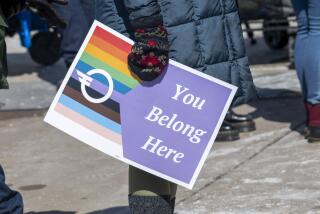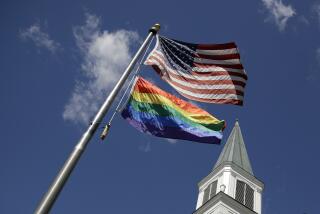Congress Reflects U.S. Religious Mix, Survey Says
WASHINGTON â The 105th Congress, now getting down to business, may not look like America in terms of class, race or gender. But when it comes to religion, members are fairly representative of the nation, according to a new survey of congressional religious affiliations.
Although religious affiliation is not an absolute indicator of political ideology, analysts say the survey confirms that the generally conservative political tone of the new Congress corresponds to a growth in the number of theologically conservative representatives and a decline in the number of mainline Protestants, who tend to be more theologically liberal.
âSlowly but surely, the changing religious configuration in Congress represents the changing landscape of American religious experience,â said Albert J. Menendez, the demographer who conducted the study.
âReligion is only one factor of many, but itâs important not to lose sight of the fact that in the American context, religion has always translated into political action and political conviction.â
According to Menendez, associate director of the Silver Spring, Md.-based Americans for Religious Liberty, Roman Catholics remain the largest single religious group in Congress, with 151 of the 535 members. Catholics, also the largest religious group in the United States, have had the largest congressional presence since 1964.
Southern Baptists, the nationâs second-largest religious group, have the second-largest congressional presence, with 67 members.
Rounding out the top religious groups in the 105th Congress are United Methodists (59), Presbyterians (55), Episcopalians (42), Jews (35), unspecified Protestants (28), Lutherans (22), Mormons (14), United Church of Christ members (10) and âChristiansâ (10).
Menendez also found six Eastern Orthodox Christians, 30 members who belong to a variety of smaller religious organizations, and seven who list no religious affiliation.
This year, for the first time ever, there is one representative from the Reorganized Church of Jesus Christ of Latter Day Saints, a Missouri-based group that is separate from the Utah-based Church of Jesus Christ of Latter-day Saints (Mormons). There are no Muslims, Hindus or Buddhists listed in Menendezâs survey.
Overall, Menendez said, the numbers track relatively closely to trends in American religious life--with some notable exceptions, such as the Jewish community, whose congressional presence is significantly higher than its roughly 2% proportion of the population.
The survey numbers are similar to those of the 104th Congress, elected in 1994.
One of the most interesting trends, Menendez said, is a âcomplete nose diveâ in the number of mainline or âestablishmentâ denominations in Congress.
Episcopalians, for example, have now dropped to their lowest representation in 50 years. There are only half as many Episcopalians in Congress (42) as there were in 1980, when Ronald Reagan first won the presidency. Similarly, United Methodists, members of the United Church of Christ and Unitarian Universalists are at their lowest numbers in 50 years.
More to Read
Sign up for Essential California
The most important California stories and recommendations in your inbox every morning.
You may occasionally receive promotional content from the Los Angeles Times.









